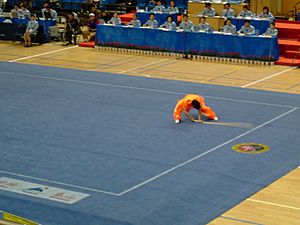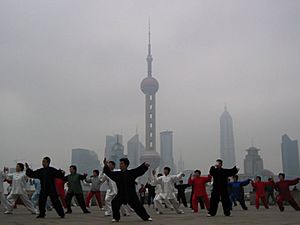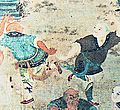Chinese martial arts facts for kids
Quick facts for kids Chinese martial arts |
|||||||
|---|---|---|---|---|---|---|---|
| Traditional Chinese | 武術 | ||||||
| Simplified Chinese | 武术 | ||||||
| Literal meaning | martial art | ||||||
|
|||||||
Chinese martial arts are also known as wushu (say "woo-shoo") or kung-fu. These are many different fighting styles that have grown over hundreds of years in China.
These fighting styles are often grouped together. Some groups are called "families" or "schools." For example, some styles copy animal movements. Others are inspired by old Chinese ideas like Taoism. Some styles focus on qi (say "chee"), which is like inner energy. These are called "internal" styles. Other styles focus on making muscles and the heart strong. These are called "external" styles. Martial arts are also often grouped by where they came from in China, like "northern" or "southern" styles.
Contents
History of Chinese Martial Arts
Chinese martial arts started because people needed to protect themselves. They also helped with hunting and military training in ancient China. Learning how to fight with your hands and with weapons was very important for ancient Chinese soldiers.
The Shaolin style of kung fu is one of the first well-known Chinese martial arts. Between the 1500s and 1600s, many records show that monks at Shaolin practiced martial arts. This practice became a big part of their lives at the monastery.
Famous Martial Artists
Here are some famous people who practiced Chinese martial arts:
- Ng Mui (late 1600s) was a legendary female master. She is said to have created many Southern martial arts. These include Wing Chun and Fujian White Crane. She is often seen as one of the "Five Elders." These were masters who survived the destruction of the Shaolin Temple.
- Yang Luchan (1799–1872) was an important teacher of t'ai chi ch'uan. This is an "internal" martial art. He taught in Beijing in the late 1800s. Yang started the Yang-style t'ai chi ch'uan style. He also shared this art with other t'ai chi families.
- Ten Tigers of Canton (late 1800s) was a group of ten top martial arts masters. They lived in Guangdong (Canton) near the end of the Qing Dynasty (1644–1912). Wong Kei-Ying, who was Wong Fei Hung's father, was part of this group.
- Wong Fei Hung (1847–1924) was a Chinese folk hero. More than 100 movies from Hong Kong were made about his life. Famous actors like Sammo Hung, Jackie Chan, and Jet Li have played him in movies.
- Huo Yuanjia (1867–1910) started the Chin Woo Athletic Association. He was famous for his public matches against foreign fighters. His life story was shown in the movie Fearless (2006).
- Yip Man (1893–1972) was a master of Wing Chun. He was the first to teach this style openly. Yip Man was the teacher of Bruce Lee. Many of the Wing Chun styles taught today came from Yip Man's students.
- Gu Ruzhang (1894–1952) was a Chinese martial artist. He helped spread the Bak Siu Lum (Northern Shaolin) martial arts system. He taught it across southern China in the early 1900s. Gu was known for his "Iron Palm" hand training.
- Bruce Lee (1940–1973) was a Chinese American martial artist and actor. He was a very important person in the 1900s. He practiced Wing Chun and made it famous. He later created his own martial arts philosophy called Jeet Kune Do. This style uses very few movements but has a big effect on opponents.
- Jackie Chan (born 1954) is a Chinese martial artist and actor. He is known for adding funny moves to his martial arts. He also does amazing stunts in his movies.
- Jet Li (born 1963) was a five-time sport wushu champion in China. He later showed his skills in movies.
- Donnie Yen (born 1963) is a Hong Kong actor and martial artist. He also directs and produces films. He is known for his action choreography and was a world wushu tournament medalist.
- Wu Jing (born 1974) is a Hong Kong actor and director. He was part of the Beijing wushu team. He started as an action choreographer and then became an actor.
Chinese Martial Arts in Movies and TV
You can find Chinese martial arts ideas in many popular movies and TV shows. For a long time, their influence was mostly in books and performances in Asia. But now, these influences are in movies and TV for a much bigger audience. Because of this, Chinese martial arts are popular all over the world.
In modern times, Chinese martial arts led to a type of movie called the Kung fu film. The movies of Bruce Lee helped make Chinese martial arts very popular in the West in the 1970s. Bruce Lee was a huge international star. He made Chinese martial arts famous with his own style, Jeet Kune Do. This was a mix of different martial arts that Bruce Lee learned and mastered. His unique style used very small movements to get the most effect against his opponents. Bruce Lee's movies helped Chinese martial arts become popular in Western movies.
Martial artists and actors like Jet Li and Jackie Chan have kept these movies popular. Jackie Chan added humor to his fighting style in his films. Martial arts films from China are often called "kung fu movies." If they use a lot of wires for special effects, they are sometimes called "wire-fu." These movies are part of the kung fu theater tradition. The skills of these actors made Hong Kong movies very popular around the world.
In Western countries, kung fu has become a common action style. It appears in many films that are not just "Martial Arts" movies. Some examples include The Matrix Trilogy, Kill Bill, and The Transporter.
Related Pages

- Eighteen Arms of Wushu
- Hard and soft (martial arts)
- Kung-fu
- List of Chinese martial arts
- Wushu (term)
- Wushu (sport)
Images for kids
-
A painting from the early 1800s. It shows fighting monks showing their skills to visitors at the Shaolin Monastery.
-
Two Brazilian fighters in a Sanda/Sanshou match. Sanda is a modern form of Kung Fu and one of the two parts of Sport Wushu.
See also
 In Spanish: Artes marciales de China para niños
In Spanish: Artes marciales de China para niños









